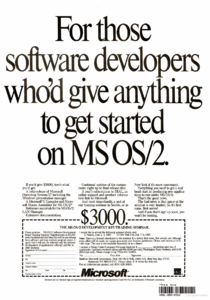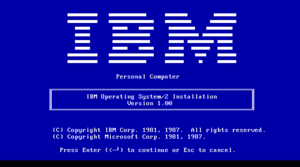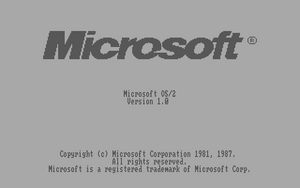OS/2 Research Outline
This is a set of wiki pages dedicated to researching the rise and fall of OS/2, with the intent on creating a larger record of the 16-bit and early 32-bit era of IBM's ill fated operating system, with stream ideas, research notes, discussion and more.
This is an effort to fundamental answer is to document the reasons as to why despite IBM's best efforts, OS/2 failed in the marketplace in favor of Windows 3.0, an operating system that is technically inferior in almost all regards.
Goals Of This Project
The fundamental goal of this project is to create a pretty definitive guide to the early history of OS/2, including showing how it worked, functioned, and more as a primary source, and should interest remain, the creation of multiple realtime videos and/or documentaries to document one of the more pivotal moments of the late 1980s, and early 1990s.
This wiki page should use citations for all major facts and statements, as they will be cited in any video. It's expected that each top level section will become its own "realtime video" at some point.
Overview of the 16-bit Era of OS/2
Because the level of general knowledge of OS/2 is so low, a basic understanding has to be established about the 16-bit era needs to be established. The closest thing to a canonical document on this era exists at the OS/2 Museum, but setting up usable and working systems with native apps is essential ...
Understanding The Pricing Of Equipment for OS/2
OS/2 runs decently on maxed out equipment, but that's easily going into five figures or more. We need to figure out what was acceptable for a developer system in this era ...
It should be important to research what hardware each version of OS/2 may have run on. For example, CGA cards on the AT were pretty common. Understand how OS/2 behaved on low end hardware vs. Windows of the era.
Another important note is that OS/2 was created as a replacement to Microsoft's Xenix (a licensed port of AT&T). The chronology here should be determined to understand more factors of the OS/2 mess.
Things to research:
- OS/2-Xenix chronology
- Typical low, medium, and high end PC hardware of the era
- What, besides DOS, was actively used in this time period
OS/2 Pre-alphas and 1.0

What was the actual intended goals of OS/2? It's often cited that OS/2 was intended to deal with the shortcomings of DOS, namely lack of multitasking and memory restrictions, but is this actually true?
It's known that Microsoft offered a $3,000 SDK and training materials which had basically everything you could want and more in a single box[1], but IBM based material is somewhat scant ...
Topics to be researched:
- Descriptions of OS/2 (or ADOS) as found in early programming reference manuals
- Comparison of early alpha versions of OS/2
- In-depth reading and review of the manual and more
Questions to be answered:
- What were the stated goals of OS/2?
- What was actually provided out of the box in 1.0?
- IBM marked OS/2 as a server - understanding the relationship here is important
OS/2 Editions


In general, OS/2 was first created for IBM hardware, and then by Microsoft, resold for other PC compatible vendors. OS/2 was also available directly from Microsoft as an upgrade. There are known code and behavior differences between the two editions, as well as significant differences in documentation. However, all editions of OS/2 should be able to run the same binaries.
In general, IBM branded versions only ran properly on IBM machines or extremely compatible clones, while Microsoft versions were, for the most part, more forgiving.
IBM Edition
IBM editions are generally considered the "canonical" branch of OS/2, as they were developed for and used on IBM's PS/2 line of machines, which were generally the highest end machines with microchannel architecture support. If you were going to shell out the money for a MCA system in the late 1980s, you almost certainly were running either OS/2 or Xenix.
Microsoft Edition
IBM Extended Edition
LAN Manager
OS/2 as a Server
Understanding the OS/2 Development Environment
Hello World on OS/2 1.0-1.3
Comparison to DOS and Creating Family Mode applications
Exploring Native OS/2 Apps
Limits of Preemptive Multitasking
Capabilities and Limitations of OS/2
How Hamstrung was OS/2 By the 286
HPFS
Use of Segmentation in Protected Mode (such as IOPL)
Networking with NetWare/LAN Server/LAN Manager
DOS/Windows Compatibility
Later OS/2 Era Stuff Worth Researching
- OS/2 on PowerPC
- Embedded OS/2 such as on the New York City Subway
- eCommStation and AcraOS